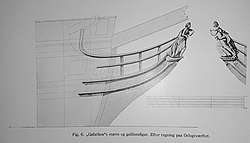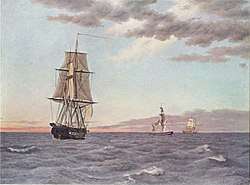HDMS Galathea (1831)
HDMS Galathea was a three-masted corvette, build for the Danish Navy. It had a single, closed cannon deck and was equipped with 26 18-pound cannons, two of which where on the forecastle and two on the quarterdeck. It was a full-rigged ship, with royals and skysails on all three masts. However, the ship keeled over too much under all sails and the masts were shortened and sails reduced in 1844. The ship carried one longboat and four smaller boats.[1]

 HDMS Galathea in the North Sea. Painting by Eckersberg | |
| History | |
|---|---|
| Name: | HDMS Galathea |
| Builder: |
|
| Yard number: | 24 |
| Laid down: | 2 April 1831 |
| Launched: | 6 October 1831 |
| Commissioned: | 1833 |
| Decommissioned: | 4 July 1861 |
| Homeport: | Copenhagen |
| Name: | Galathea |
| Owner: | Tradinghouse Mohr & Kjær |
| In service: | 1862 |
| Out of service: | 1875 |
| Homeport: | Copenhagen |
| Name: | Galathea |
| In service: | 1875 |
| Out of service: | 1889 |
| Homeport: | Arendal |
| Fate: | Wrecked at Oran, Algeria in 1889 |
| General characteristics | |
| Class and type: | Corvette |
| Length: | 43.5 m (143 ft) |
| Beam: | 10.5 m (34 ft) |
| Draught: | 4.5 m (15 ft) |
| Sail plan: | Full-rigged ship, 1560 m2 |
| Speed: | up to 11 knots |
| Complement: | 216 |
| Armament: | 26 x 18 pound cannons, 6 x 4 pound howitzer |
Galathea was on its first overseas voyage to the Mediterranean in 1833 and again in 1839. On the return from the latter journey, under command of Jens Seidelin, Galathea brought home 47 boxes of sculptures by Bertel Thorvaldsen from Rome to Copenhagen, as well as a couple of marble blocks for the sculptor Herman W. Bissen.[2] Thorvaldsen had returned to Copenhagen the previous year, after having worked in Rome since 1797.
After a major overhaul in 1844 Galathea launched on a circumnavigation of the world (known as the first Galathea Expedition) in 1845-1847, under command of Commander Steen Andersen Bille. The expedition left Copenhagen 24 June 1845 and returned 31 August 1847. It served combined scientific and diplomatic purposes and took a route south of Africa to the Indian subcontinent, past Japan and the Sandwich Islands (Hawaii) across the Pacific, south of Cape Horn and across the Atlantic towards Copenhagen.

The scientist on board were Didrik Ferdinand Didrichsen (physician and botanist), Bernhard Casper Kamphǿvener (botanist), Carl Emil Kiellerup (entomologist), Hinrich Johannes Rink (geologist), Wilhelm Friedrich Georg Behn (zoologist) and Johannes Theodor Reinhardt (zoologist). Also two artists, Johan Christian Thornam (drawings) and Poul August Plum (paintings) were on board. The expedition collected large amounts of zoological, botanical and ethnological artifacts, but the immediate scientific results of the expedition were limited. This was primarily due to the death of the Danish King Christian 8th in 1848 and the first Schleswig War, which started later the same year. Christian 8th was personally interested in natural sciences, much more than his son and successor King Frederick 7th. The collected artifacts were distributed among the museums in Copenhagen and Kiel.
The important diplomatic missions included strengthening of trade relationships with the Far East and South America, recolonising the Nicobar Islands and handing over the Danish trade posts in India to England.
The primary first hand account of the expedition is due to the captain in the book St. Billes Beretning om Corvetten Gaiatheas Rejse omkring Jorden from 1853.

In 1848-49 Galathea participated in the first Schleswig War, where she patrolled the western Baltic and served in the blocade of the German harbours. In April 1849 Galathea was guarding the entrance to Eckernförde, but did not participate in the Battle of Eckernförde (5 April), as she was ordered to leave for Kiel on the very morning of the battle.[1] In the following days Galathea participated in the transfer of troops to the fighting at Bov and to Eckernförde, together with HDMS Gejser, HDMS Hekla and HDMS Najaden.[2] Later the same year Galathea together with the brig HDMS St. Crois blocked the German port in Pillau, where they took part in the fighting with the Preussian armoured steamer SMS Preußischer Adler, which was forced to withdraw to Danzig.[2] After the war Galathea served briefly as guard vessel in the Sound.
Galathea was sold to the private company Mohr & Kjær, Copenhagen, in 1862 and rigged as a bark. Until 1870 she sailed emigrants from Bergen and Tronheim to Canada and was sold to Arendal in Norway in 1875. Galathea was lost at Oran, Algeria, on 11 May 1889.
Known Commanders[3]
- 1833 Commander J. V. C. Krieger
- 1837 Commander M. Lütken
- 1839 Commander J. Seidelin
- 1845-1847 Commander Steen A. Bille
- 1848-1849 Commander C. L. Prøsilius
- 1852 Lieutenant Commander P. C. Holm
- 1854 Commander C. N. Wulff
References
- Bjerg, Hans Christian (2010). Orlogsflådens skibe gennem 500 år. Copenhagen: Danish War Museum.
- Sandbeck, Thorkil (2007). Danske Havforskningsskibe gennem 250 år. Stenstrup, Denmark: Skib Forlag.
- "Galathea on navalhistory.dk". Archived from the original on 5 November 2011. Retrieved 17 February 2019.